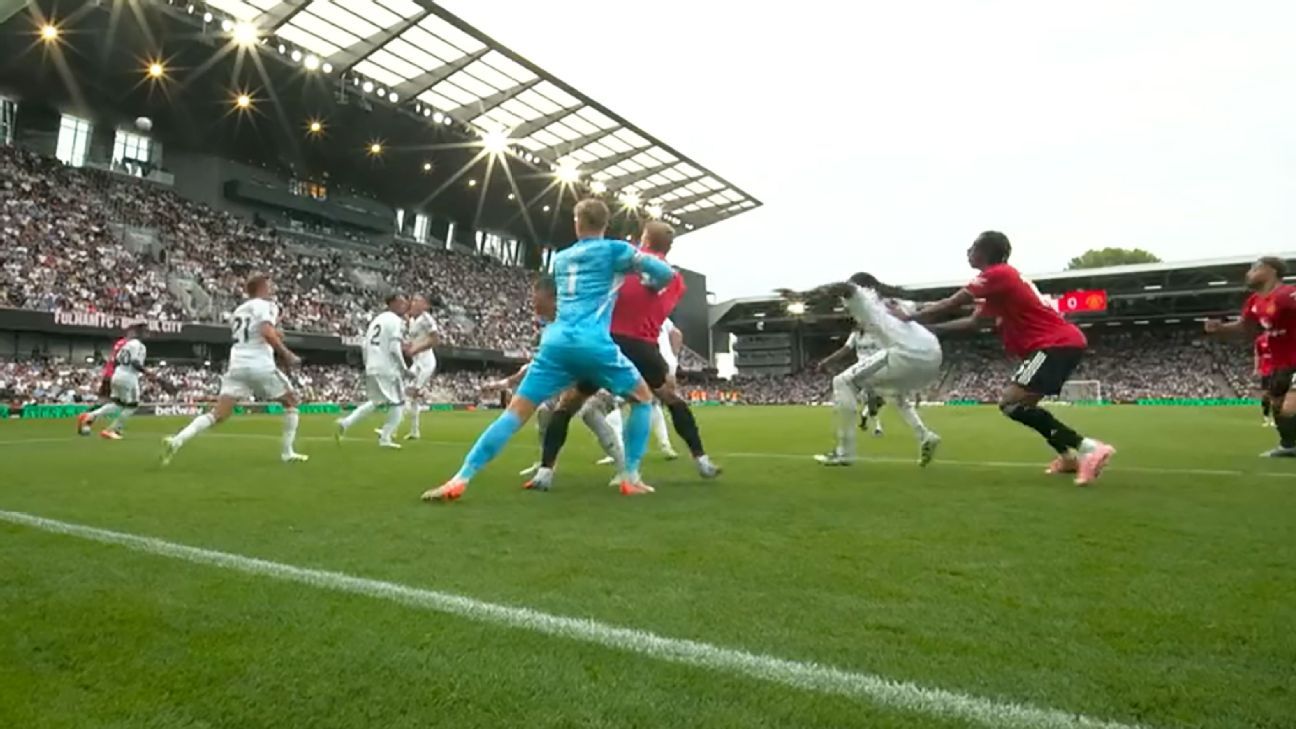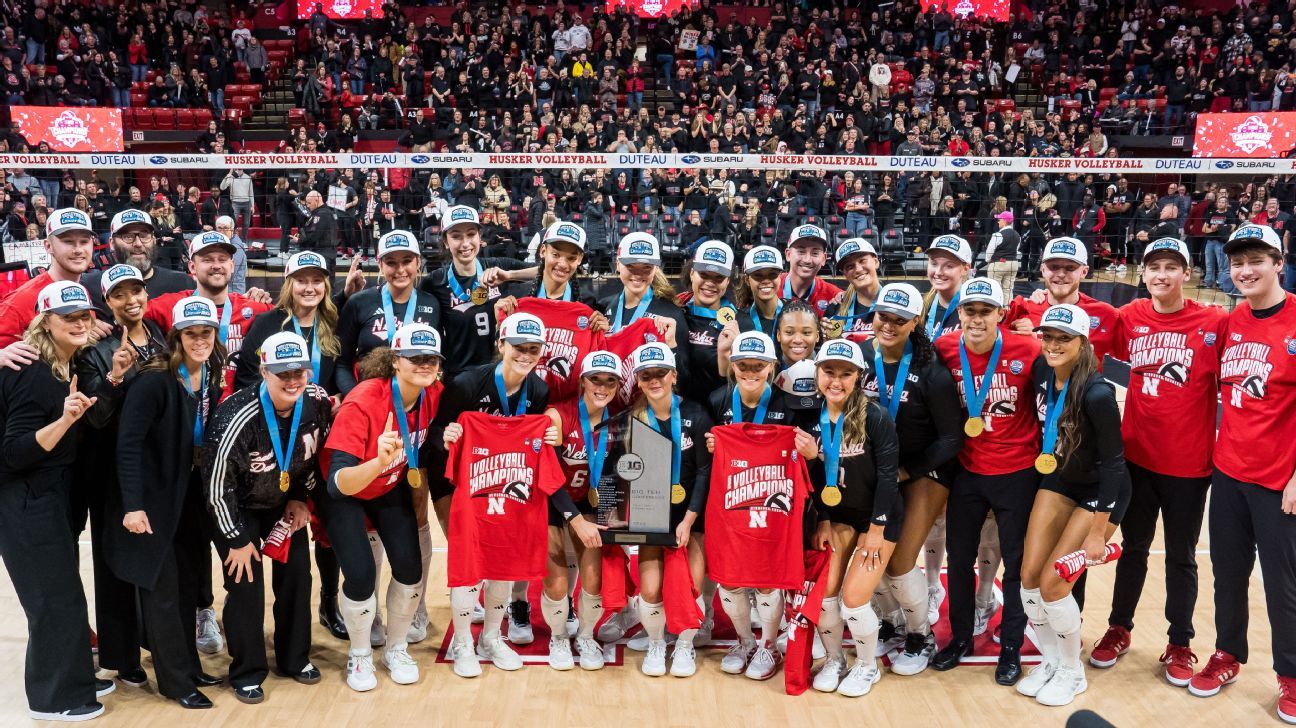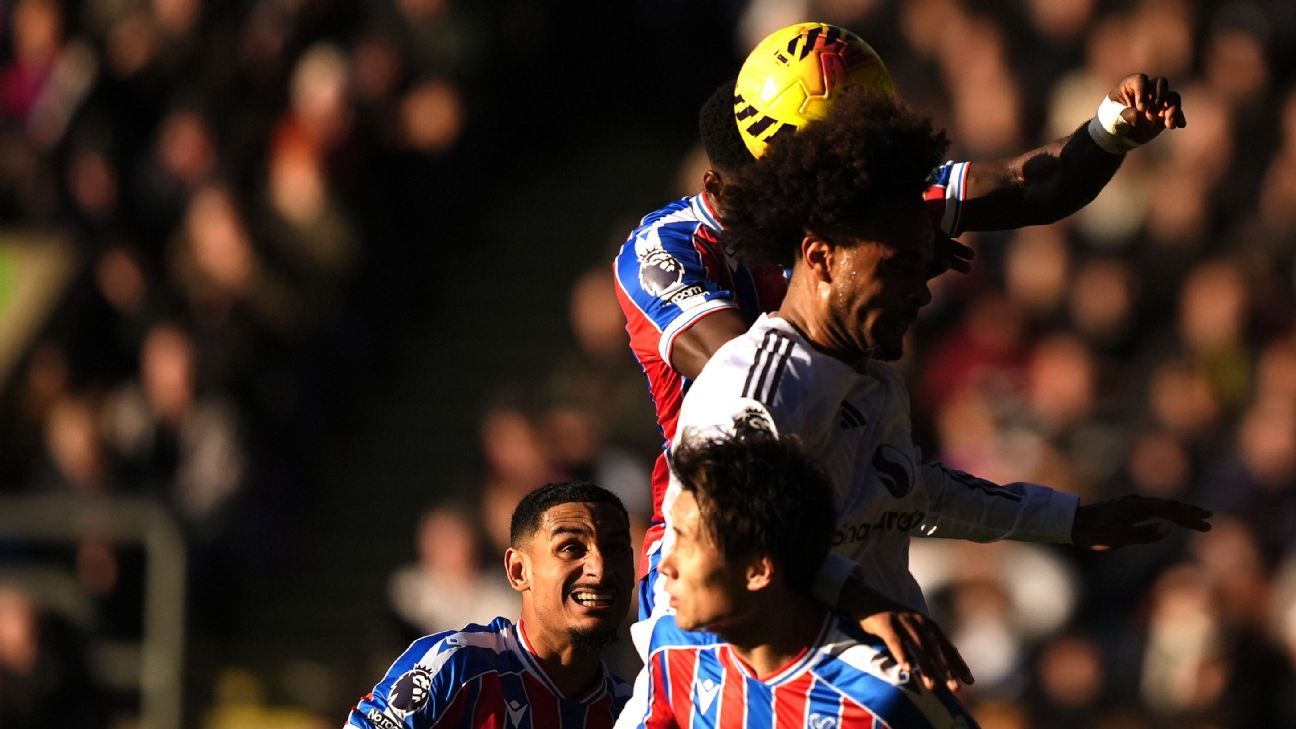Sports
The VAR Review: Why Man United’s goal wasn’t ruled out; Trafford’s red-card escape

Video Assistant Referee causes controversy every week in the Premier League, but how are decisions made, and are they correct?
After each weekend we take a look at the major incidents, to examine and explain the process both in terms of VAR protocol and the Laws of the Game.
In this week’s VAR Review: Looking at why Manchester United were awarded a penalty at Fulham but their goal was allowed to stand. Plus, should Manchester City goalkeeper James Trafford have been sent off against Tottenham Hotspur?
Possible disallowed goal: Challenge by Yoro on Bassey
What happened: The game was in the 58th minute when Man United won another corner. Bryan Mbeumo delivered into the danger zone, with Leny Yoro‘s header deflecting into the back off the net off Fulham‘s Muniz. However, Yoro appeared to push Bassey as the ball came into the box, and that was looked at by the VAR.
VAR decision: Goal stands.
VAR review: The VAR doesn’t step in to disallow a goal for a foul very often in the Premier League — last season it happened just four times and only one of those involved this specific type of offence (Sepp van den Berg‘s effort for Brentford against Leicester City ruled out for holding by Yoane Wissa on Jan Bednarek.) No VAR error was logged across the season by the Key Match Incidents Panel for a foul in the buildup to a goal.
It’s easier to find examples of pushes which were not penalised — Joelinton on Gabriel Magalhães when Newcastle scored against Arsenal two years ago; or Beto on Ibrahima Konaté for Everton’s late goal vs. Liverpool in February.
Verdict: With the high bar in the Premier League, there is a reluctance to get involved in this kind of situation, with the belief that an attacking player is allowed to create space and the referee should be making the decision. However, if the VAR is getting involved in the earlier defensive infringement, it feels inconsistent that they would not intervene when Yoro’s push with both arms prevented Bassey from being able to challenge for the ball.
– Ogden: New season, same problems for Manchester United
– O’Hanlon: The best worst transfers that should have worked
– How did Arsenal beat Spurs to Eze, and why do they need him?
![]()
The VAR argued that this level of contact wasn’t impactful, but it’s difficult to see how that can be the case when the United player was left free to direct a header which led to a goal.
The Premier League’s high bar for intervention — 83% of stakeholders voted that the current level should be maintained, with only 8% feeling it should be lowered — creates a situation where fouls such are left on the field. But for many supporters, it leaves the perception of a “big club decision” from the VAR.
And, of course, we have examples of very similar pushes being given as a foul on-field — such as Enzo Fernández‘s disallowed goal for Chelsea at Brighton & Hove Albion last season.
Possible penalty: Challenge by Bassey on Mount
What happened: Manchester United had a corner in the 33rd minute. As the ball came into the area, several players went to ground through grappling and holding but referee Chris Kavanagh allowed play to continue. It then became clear a VAR check was being made for a possible penalty over a foul by Calvin Bassey on Mason Mount, yet it was one minute and 45 seconds until the referee was sent to the monitor by the VAR, Darren England.
VAR decision: Penalty, missed by Bruno Fernandes.
VAR review: At the start of the season, Premier League refs’ chief Howard Webb made it clear that there would be a focus on holding inside the area. Not the simple contact stuff, but the clear non-footballing actions.
“What we’ve said to the officials is if you get one of those situations where one player is clearly dragging another one to the floor in an extreme non-football action, even if it’s off the ball, we expect the referee to see it,” Webb said. “Or if it’s a clear one, then the VAR will intervene and recommend the referee looks at it at the screen because it fits the criteria that we’ve laid out. An extreme non-footballing action which prevents an opponent from moving.”
Webb also made it clear that there wouldn’t be a huge spike in penalties for this, as it was about catching the excessive examples — and that’s what England felt he saw here.
Bassey does throw Mount to the ground and has no interest in playing the ball, in a similar way to the VAR penalty awarded to Newcastle United at Everton at the start of last season — when James Tarkowski dragged down Sandro Tonali.
It’s confusing, however, that the VAR only showed the referee the “high behind” camera angle; there were other angles that showed the nature of the challenge more clearly. It may well be that the VAR felt this was the best to show that the offence by Bassey came before a possible foul by Luke Shaw on Rodrigo Muniz — or that it didn’t reach the threshold for a foul. And just because there was other holding taking place inside the area doesn’t mean the VAR won’t intervene if they feel there is a more serious offence
The “high behind” camera did make it clear that Mount was being “thrown” by Bassey, while Shaw was only holding onto Muniz. So, Bassey’s actions came first and a penalty is justified.
Verdict: The issue with holding offences is always going to be consistency, but the new guidelines have been brought in punish the more-obvious examples and not make football a non-contact sport on set pieces. There won’t be a flood of penalties for this.
However, when a VAR intervention happens the game should go back to that point — so the three minutes lost from the ball being in play to the end of the the review should be replayed, but only two minutes were added on at the end of the half.
Possible red card: Challenge by Trafford on Kudus
What happened: Mohammed Kudus ran onto a ball through the center in the 40th minute, and Manchester City goalkeeper James Trafford came out of his area. The pair collided, with Kudus going down and Trafford then able to clear. Referee Peter Bankes allowed play to continue, and it was looked at by the VAR, Andy Madley, for a possible red card.
VAR decision: No red card.
VAR review: One thing we can be sure of is that this was a foul and should have been called as such by the referee, who was perhaps fooled by the way Trafford came away in possession of the ball. The VAR can’t get involved in a simple free kick, but they can if there should have been a red card — and the chronology is important.
The first aspect to consider is denying a goal-scoring opportunity (DOGSO) by handball. A goalkeeper doesn’t have different handball factors to an outfield player, the arm still has to be extended away, in an unexpected position or there be a deliberate act. Trafford had his arm close to his body and didn’t move it, or his body, to the ball. The ball came at him from very close proximity off Kudus. This won’t be considered a handball offence and there shouldn’t be a VAR intervention.
Second, a possible red card for serious foul play. Trafford took a considerable risk in going into the challenge with Kudus with a raised knee, but he didn’t go into the challenge with excessive force or directly into the opponent, so this would not reach the bar for a red card.
Now back to DOGSO, this time for the challenge — the potential foul could stop Kudus being through to an empty goal. Does the foul come before, at the same time, or after Trafford gets a touch? This is important for DOGSO, because the direction the ball is travelling decides the quality of a scoring chance — if it exists at all.
So, if there is no handball, it’s a play of the ball by Trafford, and from that point it can be deemed that there is no chance of the Tottenham Hotspur player taking control.
It’s like the possible DOGSO against Spurs goalkeeper Guglielmo Vicario vs. Brentford last season. He handled the ball outside the area, but the ball dropped behind Mikkel Damsgaard so it couldn’t be considered a DOGSO situation.
Verdict: DOGSO is very often about the perception of where it happens on the pitch, when it’s really the ball which is the key factor — along with the position of opponents.
Take Andrew Robertson‘s DOGSO red card for Liverpool vs. Fulham last season. There were clear questions about any kind of scoring chance for Harry Wilson, but as the foul happened just outside the area as the “last man” there was very little controversy.
A situation like with Trafford, and Vicario, can look and feel like it should be a DOGSO red card, but there could be one crucial element missing which means the VAR won’t get involved.
There’s just about enough doubt in the chronology of the incident for Trafford to avoid a red card through VAR, but it wouldn’t have been overturned if given by the referee. That said, most fans will believe this looks like a DOGSO red card.
Possible penalty: Challenge by Van de Ven on Bobb
What happened: Tottenham goalkeeper Vicario played a short pass to Micky van de Ven inside his area in the 52nd minute, but the Netherlands international defender miscontrolled the ball, allowing Oscar Bobb to steal it. It ran to Erling Haaland, who attempted to find Rayan Cherki — however he was penalised for a foul on João Palhinha. Bobb was on the ground asking for a foul, but it wasn’t spotted by the referee.
VAR decision: No penalty.
VAR review: With the on-field decision carrying all the weight with VAR, there will often be similar decisions across a weekend with opposite outcomes — and often it’s the more-obvious foul which isn’t punished.
The ball has gone when Van de Ven stands on the foot of Bobb, and we’ve seen other instances when the VAR has intervened — such as when Chelsea midfielder Fernández was penalized for stepping on Manchester United‘s Antony.
Yet later on Saturday, Arsenal were given a penalty when Leeds United‘s Anton Stach trod on Max Dowman — the contact in that case appearing to be far less significant. (watch here)
Verdict: In both the Arsenal and Man City cases, the on-field decision was allowed upheld, which was understandable with Stach’s challenge. The high threshold will always give the perception of inconsistency.
Van den Ven makes contact on the top of Bobb’s foot after the ball has gone, and this should have been a penalty.
Possible handball: Saliba on Timber goal
What happened: Arsenal scored their fourth goal in the 56th minute when Jurriën Timber netted from close range following a corner routine. But was there a case of handball against William Saliba before the ball dropped to Timber?
VAR decision: Goal stands.
VAR review: Accidental handball is only an automatic offence if it’s by the goal scorer. As Timber scored, Saliba’s act either had to be deliberate or his arm needed to be in a position which wasn’t justifiable for his movement.
Verdict: It wasn’t clear if the ball did indeed touch Saliba’s arm, but there wasn’t anything that could be penalised for handball if it did.
Possible goal: Foul by Collins on Martínez
What happened: Brentford thought they had scored a second goal in the 43rd minute when Mikkel Damsgaard lashed home a loose ball after a long throw. Referee Tony Harrington disallowed it for a foul by Nathan Collins on goalkeeper Emiliano Martínez. Should there have been an intervention by the VAR, Tim Wood?
VAR decision: No goal.
VAR review: We’re back to the weight of the on-field decision, this time comparing to last week’s goal for Arsenal at Manchester United and Saliba’s challenge on Altay Bayindir.
The actions of Collins and Saliba were very similar, but one goal was disallowed and the other was given — both decisions taken by the referee.
Verdict: The VAR will stand by the on-field call because Collins seemed to be moving into Martínez, but it’s exceptionally soft and in a case like this, where the fault really does lie with the goalkeeper, an intervention would be a better outcome.
Last season, the KMI Panel didn’t log a VAR error for a challenge on a goalkeeper, but it did say the on-field referee was wrong to rule out a goal by Newcastle United‘s Bruno Guimarães after he had put pressure on Ipswich Town goalkeeper Alex Palmer. It feels like the Panel might come to a similar judgement on this.
Possible penalty overturn: Handball by Dewsbury-Hall
What happened: Brighton & Hove Albion were awarded a penalty in the 76th minute when Kiernan Dewsbury-Hall blocked a shot by Yankuba Minteh with his hand. Referee Stuart Attwell pointed to the spot and it was checked by the VAR, James Bell. (watch here)
VAR decision: Penalty stands, Danny Welbeck‘s effort saved by Jordan Pickford.
VAR review: Everton were furious on Monday when they conceded a handball penalty at Leeds United — but there was no chance that was going to be overturned. James Tarkowski had leaned his body into the path of a shot and stopped it with his arm. In law, that the arm was close to the body was irrelevant as the player’s body movement qualifies as a deliberate act. (watch here)
The Dewsbury-Hall decision was slightly more contentious, but he moved his arm into a raised position as Minteh takes his shot — and that makes it very difficult for the VAR to get involved.
Verdict: We’ve already had three handball penalties this season, all given by the on-field referee. That’s already beaten the total for 2024-25, when two were whistled on the pitch (plus seven through VAR).
Handball will always be contentious, especially those given, but the KMI Panel won’t judge either of these to be incorrect.
Possible red card: Violent conduct by Adringra
What happened: Simon Adingra was shown a yellow card in the 19th minute after he raised his hand to the face of Hannibal Mejbri. Referee Michael Salisbury only showed a yellow card to the Sunderland player, but was there a case for a red card? It was checked by the VAR, John Brooks.
VAR decision: No red card.
VAR review: There’s a misconception that raising an arm to the face is automatically a red card, but it’s not that straightforward.
The law on violent conduct states that “a player who, when not challenging for the ball, deliberately strikes an opponent or any other person on the head or face with the hand or arm, is guilty of violent conduct unless the force used was negligible.”
And it’s the last six words which saved Adringra.
Verdict: Referees are asked to consider if a player’s actions are petulant or violent for the incident to cross from a yellow card to a red, and a caution is justifiable in this case. There was no force in the way Adringra put his hand to the face of Hannibal.
Sports
Huskers earn top overall seed in volleyball tourney

Undefeated Nebraska earned the No. 1 overall seed in the NCAA women’s volleyball tournament bracket released Sunday.
The five-time national champion Huskers (30-0) have dominated this season, dropping just seven sets. They lead Division I in hitting percentage at .352.
Dani Busboom Kelly, who won NCAA titles as both a Nebraska player and assistant, took over at her alma mater this season after longtime Huskers coach John Cook retired. Busboom Kelly led Louisville to the NCAA final in 2024, where the Cardinals lost to Penn State.
The other No. 1 seeds are Kentucky, Texas and Pitt. The Wildcats have won one NCAA title, and the Longhorns have four. The Panthers reached the final four the past four seasons but lost in the semifinals each time.
Pitt and Stanford finished tied atop the ACC at 18-2, and the Cardinal won their head-to-head matchup 3-2 at Stanford on Nov. 14. But the Panthers’ overall body of work secured them the last No. 1 seed, while nine-time NCAA champion Stanford is the No. 2 seed in Texas’ region.
SEC regular-season and tournament champion Kentucky defeated Texas 3-2 in the conference tournament final. They would face each other in the national semifinals should they advance that far.
Defending national champion Penn State, the only school that has appeared in every NCAA tournament dating back to the event’s start in 1981, is a No. 8 seed in Texas’ quarter of the bracket. St. Thomas (Minnesota) and Toledo are both making their first appearance in the tournament.
The Big 12 led all leagues with 10 teams in the field, the Big Ten has nine, the ACC seven and the SEC five.
Early-round matches will be held from Dec. 4 to 6 on campus sites. The regionals, scheduled for Dec. 11-14, will be hosted by the four highest seeds still standing in each quarter of the bracket.
The final four is at T-Mobile Center in Kansas City, Missouri, for the third time in the tournament’s history. It was there that Penn State won the championship in 2010 and Nebraska won its most recent title in 2017.
The national semifinals are Dec. 18 (ESPN), and the championship match is Dec. 21 (ABC).
Sports
Commanders vs. Broncos live updates: Washington tightens up in red zone, yields field goal
The Commanders return from their bye week searching for their first victory since Oct. 5. It won’t be easy against the Broncos, who have won eight straight.
Source link
Sports
Ruben Amorim: Man United ‘steal’ set-piece routines from rivals

Ruben Amorim has said that Manchester United are “stealing” set-piece routines from other clubs after goals from two free-kicks helped earn a valuable 2-1 win over Crystal Palace.
United came from behind at Selhurst Park thanks to second-half goals from Joshua Zirkzee and Mason Mount, both of which came from Bruno Fernandes set plays.
Amorim’s team have now scored 10 Premier League goals from set-pieces this season — joint most with table-toppers Arsenal.
“We work a lot,” Amorim said when asked about United’s improvement at set-pieces.
“We have more time to work, we work a lot and we learn a lot in England.
“I think you are used to seeing that, but when you come for the Premier League you learn a lot with other teams how to do it and we are stealing a lot of things to score goals.”
United looked destined for another set-back following Monday’s defeat to 10-man Everton when Crystal Palace went in at half-time 1-0 up thanks to a retaken penalty from Jean-Philippe Mateta.
But there was marked improvement in their performance after the break as Amorim’s team recorded just their second league win away from home since March.
“I just said to the players we need to be more alive and you can feel that,” Amorim said.
– Mason Mount, Joshua Zirkzee inspire Man United comeback win at Crystal Palace
– Zirkzee leads Man United comeback in game of two halves vs. Palace
– Premier League table
“So if you are more alive, you are in more places, you are near the ball more often. I think everyone did that.
“But we also need to understand that the opponent was tired also in the second half.
“And when you increase the rhythm and the opponent gets tired a little bit, suffers right away a goal, you felt that we had the control of the game and that’s it.”
-

 Sports1 week ago
Sports1 week agoWATCH: Ronaldo scores spectacular bicycle kick
-

 Entertainment7 days ago
Entertainment7 days agoWelcome to Derry’ episode 5 delivers shocking twist
-

 Politics1 week ago
Politics1 week agoWashington and Kyiv Stress Any Peace Deal Must Fully Respect Ukraine’s Sovereignty
-

 Business1 week ago
Business1 week agoKey economic data and trends that will shape Rachel Reeves’ Budget
-

 Tech6 days ago
Tech6 days agoWake Up—the Best Black Friday Mattress Sales Are Here
-

 Fashion7 days ago
Fashion7 days agoCanada’s Lululemon unveils team Canada kit for Milano Cortina 2026
-

 Tech5 days ago
Tech5 days agoThe Alienware Aurora Gaming Desktop Punches Above Its Weight
-

 Politics1 week ago
Politics1 week ago53,000 Sikhs vote in Ottawa Khalistan Referendum amid Carney-Modi trade talks scrutiny






